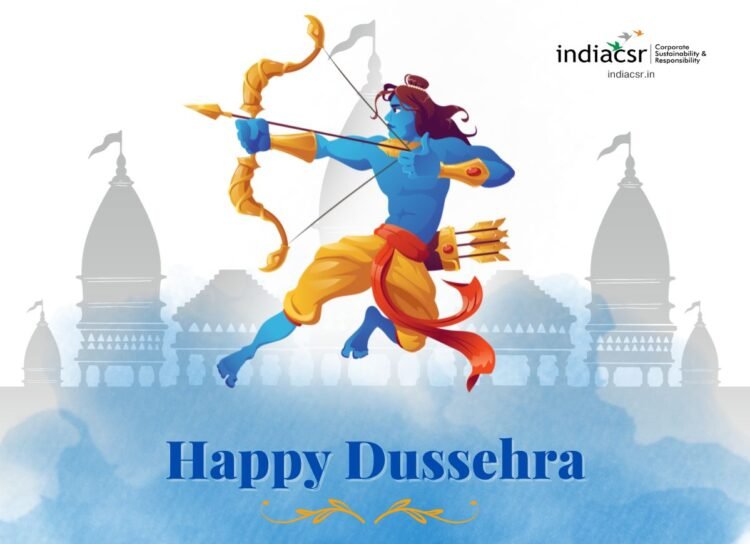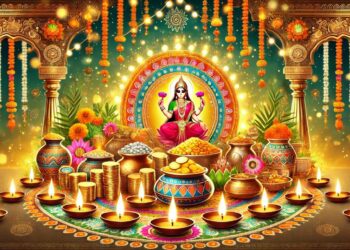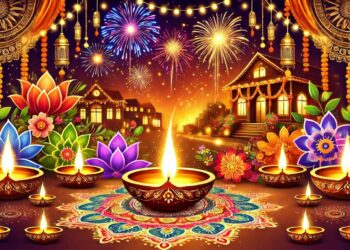Vijayadashami, popularly known as Dussehra, is one of the most important Hindu festivals celebrated across India. It marks the victory of good over evil, symbolized by Lord Rama’s triumph over Ravana and Goddess Durga’s victory over the demon Mahishasura. In 2024, Vijayadashami falls on October 12, bringing an end to the nine-day-long Navratri festivities. The day is marked by vibrant cultural performances, pujas, and the symbolic burning of Ravana’s effigies. Let’s take a closer look at the date, puja timings, and the significance of this festival.
When is Vijayadashami 2024?
Vijayadashami 2024 will be celebrated on Saturday, October 12. The festival, observed on the 10th day of the Hindu month of Ashwin, marks the culmination of Navratri and Durga Puja. As it is based on the lunar calendar, the exact date may vary slightly, but this year it falls on October 12, providing devotees the chance to come together and honor the victory of righteousness.
Vijayadashami 2024: Date and Time
The most auspicious time to perform the Vijayadashami puja, known as the Vijaya Muhurat, occurs during the afternoon. In 2024, the Vijaya Muhurat is expected to be between 1:59 PM and 2:45 PM (IST), giving devotees a short but sacred window to perform rituals and seek blessings for new beginnings.
- Dashami Tithi Ends: October 12, 2024, at 5:28 PM (IST)
- Aparahna Puja Time: 1:12 PM to 3:34 PM (IST)
- Dashami Tithi Begins: October 11, 2024, at 6:34 PM (IST)
Here are some approximate timings for Dussehra celebrations in different regions of India:
- Northern India: 5:00 PM to 7:00 PM
- Southern India: 6:00 PM to 8:00 PM
- Western India: 6:30 PM to 8:30 PM
- Eastern India: 7:00 PM to 9:00 PM
When to celebrate Vijayadashami?
Vijayadashami, also known as Dussehra, is celebrated on the 10th day of the Hindu lunar month of Ashwin, marking the end of the nine-day Navratri festival. In 2024, Vijayadashami falls on October 12. The festival symbolizes the triumph of good over evil, commemorating Lord Rama’s victory over the demon king Ravana and Goddess Durga’s triumph over Mahishasura.
It is celebrated with great enthusiasm across India, with rituals like the burning of Ravana’s effigy (Ravan Dahan) to symbolize the destruction of evil. It is an auspicious day for new beginnings and is often marked by prayers, processions, and cultural events.
Significance of Vijayadashami
Vijayadashami, also known as Dussehra, is one of the most significant Hindu festivals, symbolizing the victory of good over evil. Falling on October 12, 2024, this day marks the culmination of the nine-day Navratri festival. Vijayadashami carries deep spiritual, cultural, and moral significance, celebrated in different ways across India.
1. Victory of Lord Rama Over Ravana
The festival commemorates Lord Rama’s triumph over the demon king Ravana, symbolizing the victory of righteousness over wickedness. The burning of Ravana’s effigy, known as Ravan Dahan, represents the destruction of evil and the upholding of dharma (moral order).
2. Triumph of Goddess Durga Over Mahishasura
In many regions, Vijayadashami is also associated with Goddess Durga’s victory over the buffalo demon Mahishasura, symbolizing the triumph of good over evil and the empowerment of women. Durga Visarjan, the immersion of Goddess Durga’s idol, takes place on this day, marking the end of Durga Puja festivities.
3. New Beginnings and Auspicious Day
Vijayadashami is considered an extremely auspicious day for new beginnings. Many people initiate important ventures, educational pursuits, or professional endeavors on this day, seeking blessings for success and prosperity.
4. Symbol of Courage and Strength
The festival reinforces the importance of courage and resilience in overcoming personal challenges and societal evils. Vijayadashami serves as a reminder that good, truth, and justice will ultimately prevail.
5. Cultural Celebrations
The festival is celebrated with grand processions, cultural performances, Ramlila enactments, and the iconic Ravan Dahan. These celebrations bring communities together, spreading a sense of unity and joy.
In 2024, Vijayadashami continues to be a day of deep spiritual reflection, cultural festivity, and the celebration of justice, strength, and righteousness.
Puja Rituals of Vijayadashami
Vijayadashami, or Dussehra, is celebrated with devotion and various rituals that symbolize the victory of good over evil. Here’s a step-by-step guide to the puja rituals for Vijayadashami 2024:
1. Early Morning Bath and Cleansing
Begin the day by taking a holy bath, symbolizing spiritual purification. Wear clean or new clothes to start the day with positivity.
2. Home Decoration and Altar Setup
Clean the house and decorate it with flowers, rangoli, and diyas. Set up an altar with idols or images of Goddess Durga and Lord Rama. Place offerings such as fruits, sweets, and flowers on the altar.
3. Navratri Kalash Visarjan
If a Kalash (sacred pot) was established at the start of Navratri, it is time to perform Visarjan (immersion). Offer prayers to the Kalash and respectfully immerse it in water, symbolizing the conclusion of the Navratri festival.
4. Durga Visarjan
For those who worshipped Goddess Durga during Navratri, the Vijayadashami ritual includes Durga Visarjan, where the idol of Goddess Durga is immersed in water. Before immersion, devotees perform the final aarti (ritual worship), seeking blessings for health, prosperity, and protection from evil.
5. Shami Puja
The Shami tree holds special significance on Vijayadashami. According to Hindu mythology, the Pandavas hid their weapons in a Shami tree during their exile. Worship the Shami tree by offering flowers, turmeric, and kumkum, and seek blessings for success and victory.
6. Ravan Dahan
In many parts of India, effigies of Ravana, along with those of Meghnad and Kumbhakaran, are burnt to symbolize the victory of Lord Rama over Ravana. This event is usually accompanied by prayers, fireworks, and festivities.
7. Worship of Weapons
Vijayadashami is considered an auspicious day for performing Ayudha Puja, where tools, instruments, vehicles, and weapons are worshipped. This ritual seeks blessings for protection and success in professional endeavors.
8. Recitation of Ramayana
It is customary to recite or listen to the Ramayana, particularly the portion where Lord Rama defeats Ravana. This act is believed to bring peace, prosperity, and righteousness to one’s life.
9. Special Offerings and Aarti
Perform an aarti (prayer ritual) dedicated to Lord Rama and Goddess Durga. Offerings of sweets, fruits, and flowers are made, and the aarti concludes with the distribution of prasad (blessed food).
10. Exchange of Greetings
After the puja, it is customary to exchange Vijayadashami greetings with family, friends, and neighbors. Sharing sweets and expressing good wishes for success and prosperity is part of the celebration.
How Dussehra is Celebrated in Different States of India
Dussehra, also known as Vijayadashami, is celebrated with great enthusiasm and diverse customs across India. Each state has its own unique way of observing the festival, reflecting regional traditions, culture, and beliefs. Here’s a look at how Dussehra is celebrated in different parts of India:
1. Delhi – The Grand Ramlila and Ravan Dahan
In Delhi, Dussehra is marked by grand Ramlila performances, reenacting episodes from the Ramayana, culminating in the symbolic burning of Ravana’s effigies (Ravan Dahan). Huge crowds gather at iconic locations like Ramlila Maidan and Red Fort Grounds to witness the fireworks and the triumph of good over evil.
2. West Bengal – Durga Puja and Immersion
In West Bengal, Dussehra coincides with the culmination of Durga Puja, a grand festival celebrating the victory of Goddess Durga over the buffalo demon Mahishasura. After five days of elaborate rituals, the festival ends with Durga Visarjan, where idols of Goddess Durga are immersed in rivers or seas amid music, dance, and chanting.
3. Karnataka – Mysore Dasara
In Karnataka, especially in Mysore, Dussehra is celebrated with royal grandeur. The Mysore Dasara is famous for its vibrant processions, cultural events, and the iconic lighting of Mysore Palace. The city hosts grand celebrations with elephants, horses, and traditional music, honoring Goddess Chamundeshwari, who killed the demon Mahishasura.
4. Himachal Pradesh – Kullu Dussehra
In Kullu, Himachal Pradesh, Dussehra is celebrated as a week-long festival that begins on Vijayadashami. Thousands of devotees gather in the Kullu Valley, and idols of local deities are brought to the town in grand processions. Unlike other regions, effigies of Ravana are not burnt here, and the festival focuses on celebrating the victory of Lord Rama.
5. Gujarat – Navratri Garba and Dussehra
In Gujarat, Dussehra follows the grand Navratri celebrations, where people engage in Garba and Dandiya dances. On Vijayadashami, people perform special pujas, and effigies of Ravana are burned to symbolize the victory of good over evil. It’s also considered an auspicious day to start new ventures or purchases.
6. Maharashtra – Ramayana and Ravan Dahan
In Maharashtra, Dussehra is celebrated with Ramlila performances and the burning of Ravana’s effigies in many towns and cities. Additionally, families exchange Apta leaves (symbolizing gold) as a sign of prosperity and goodwill. It is also a day to honor weapons and tools in a ritual known as Ayudha Puja.
7. Tamil Nadu – Golu and Saraswati Puja
In Tamil Nadu, Dussehra is celebrated as part of the Navratri Golu festival, where homes display artistic arrangements of dolls representing gods, goddesses, and mythological characters. On Vijayadashami, people perform Saraswati Puja (worship of the goddess of learning), and students often begin their education or new learning ventures on this auspicious day.
8. Andhra Pradesh and Telangana – Bathukamma and Shami Puja
In Andhra Pradesh and Telangana, Dussehra marks the end of the Bathukamma festival, dedicated to Goddess Gauri. Women create floral arrangements and immerse them in water as part of the festival. Shami Puja is also performed, where people exchange Shami tree leaves, believed to bring good fortune and success.
9. Uttar Pradesh – Ramnagar Ramlila
In Uttar Pradesh, the city of Varanasi’s Ramnagar Ramlila is particularly famous for its elaborate and traditional enactments of the Ramayana, which continue for several days leading up to Dussehra. On Vijayadashami, effigies of Ravana, Meghnad, and Kumbhakarna are burned amid fireworks and celebrations.
10. Punjab – Navratri Fasting and Celebrations
In Punjab, Dussehra is celebrated with fasting during the nine days of Navratri, followed by the burning of Ravana’s effigy on Vijayadashami. The festival signifies the end of the fasting period and the beginning of joyous celebrations with family and friends.
11. Bihar – Maithil Dussehra
In the Maithil region of Bihar, Dussehra is celebrated with grand processions and Durga Puja. Vijayadashami marks the end of the festivities, and people participate in traditional rituals and Ravan Dahan to celebrate the victory of good over evil.
12. Odisha – Dussehra and Shami Puja
In Odisha, Dussehra is celebrated with Durga Puja, and people worship weapons as part of Ayudha Puja. The effigies of Ravana are burned to symbolize the defeat of evil forces, and Shami Puja is performed, signifying respect for the Shami tree and its connection to victory.
Vijayadashami is a festival that symbolizes the power of righteousness and justice over evil forces. It also inspires us to overcome our weaknesses and challenges with courage and faith. It is a day to celebrate the victory of light over darkness, truth over falsehood and good over evil.
A Time for New Beginnings
Vijayadashami is considered an auspicious day for new beginnings. Many people perform Ayudha Puja, where they worship their tools, weapons, or instruments, seeking divine blessings for success in their professional endeavors. It is also a popular day for initiating educational pursuits, with students beginning new lessons or courses.
The festival reminds us that truth, integrity, and moral duty will always prevail, no matter how difficult the circumstances. By observing Vijayadashami, devotees renew their faith in the power of righteousness and seek blessings for a prosperous future.
You Learn
Vijayadashami, or Dussehra, is a multifaceted Hindu festival that holds deep cultural and religious significance. It serves as a reminder of the eternal battle between good and evil and encourages individuals to uphold righteousness and courage in their lives. Celebrated with diverse rituals across India, it unites people in the common theme of triumphing over darkness and embracing the light of truth and goodness.
Also Read:
- Dussehra 2024: Date, History, Significance, Celebrations and Important Facts on Vijayadashami
- Essay On Dussehra (Vijayadashami) For Students
📢 Partner with India CSR
Are you looking to publish high-quality blogs or insert relevant backlinks on a leading CSR and sustainability platform? India CSR welcomes business and corporate partnership proposals for guest posting, sponsored content, and contextual link insertions in existing or new articles. Reach our highly engaged audience of business leaders, CSR professionals, NGOs, and policy influencers.
📩 Contact us at: biz@indiacsr.in
🌐 Visit: www.indiacsr.in
Let’s collaborate to amplify your brand’s impact in the CSR and ESG ecosystem.




























